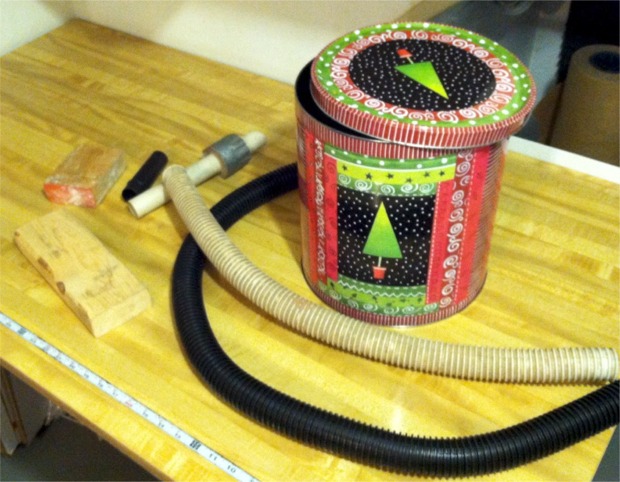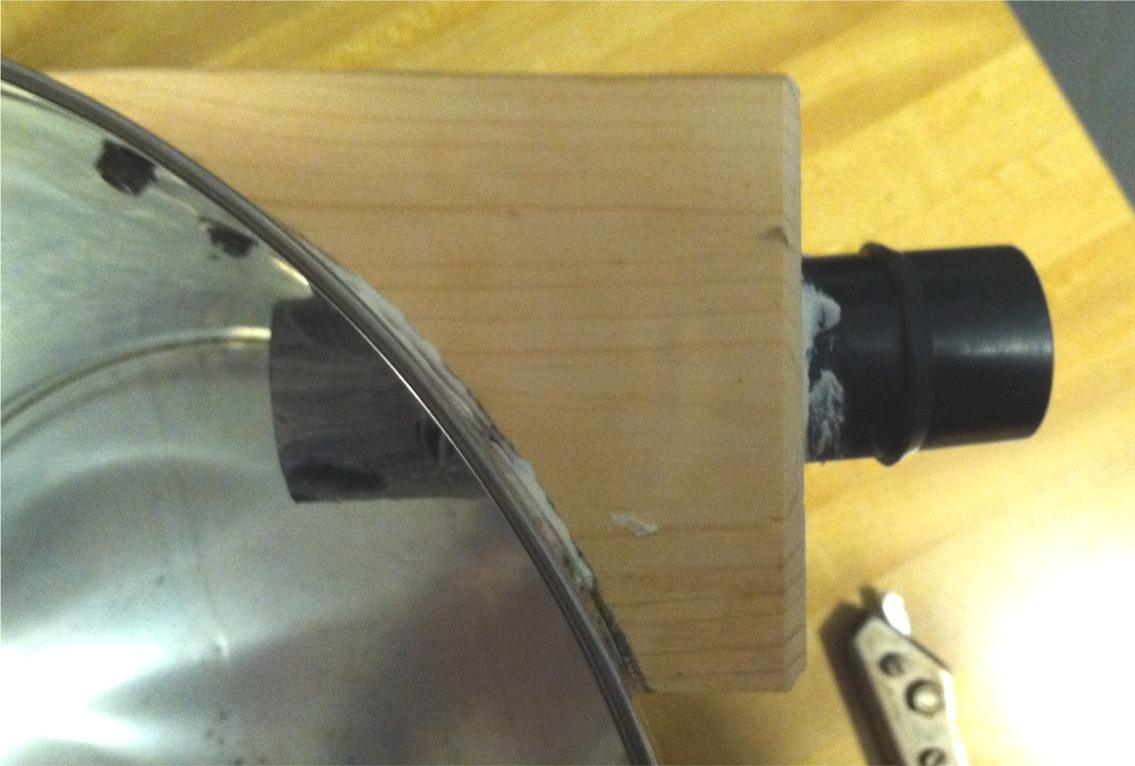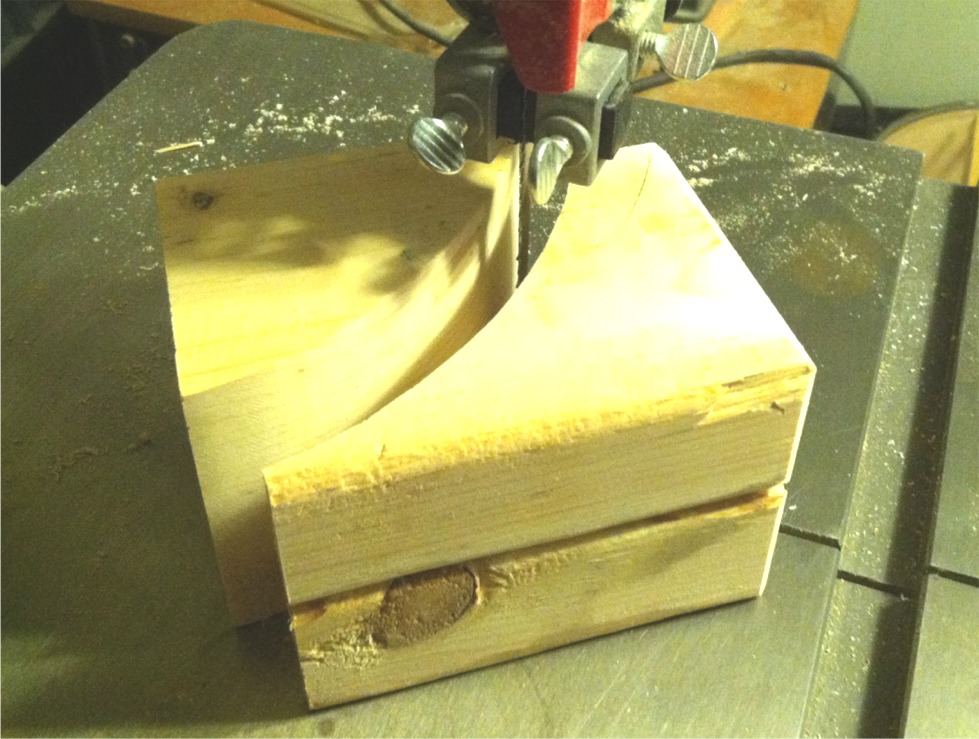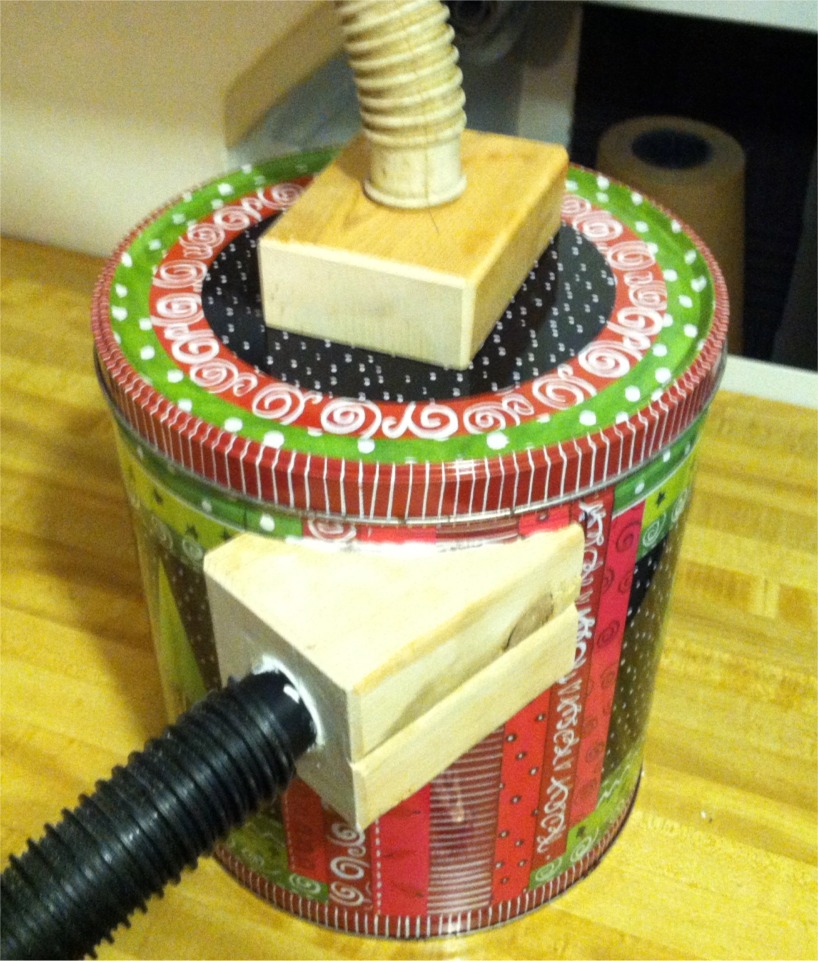
3 dimensional visualization skills are important to develop the imagination, so a good way to develop this ability is to build and work with three dimensional things. Here we share the various projects our staff have done.
It is our hope that you will see the logic (or the lack of logic) used to make your own Cyclonic Dust Collector as an example of the kind of thought and analysis that goes into our script review services.
Notice: The content presented here is for entertainment purposes only. Readers who decide to construct or modify the items mentioned here do so at their own risk and peril.
This cyclonic dust collector is for a band saw. Since the band saw makes lots of fine saw dust, connecting the band saw directly to a regular vacuum cleaner would quickly clog up the filter. This cyclonic dust collector lessens the burden on the shop vacuum, and allows it to run longer with fewer filter cleanings.
Why use a shop vacuum instead of a regular dust collection system? The Unlocked Mind Newsletter Woodshop is more for research and development purposes and low volume than large scale production, so each dust producing tool in our shop has its own vacuum cleaner attached.

Items needed for this project
Here is what you need to get started:
1. Large metal pop corn tin. An old 5 gallon plastic paint bucket and lid would also work, but in this case, the pop corn tin [cylinder] was available, and it was smaller than a 5 gallon bucket.
2. old vacuum hoses and pipes and fittings -- hoses should easily attach to the plastic pipes.
3. pieces of 2x4 lumber to secure the plastic pipes and securely hold the hoses in place.
4. Caulk -- to make air tight seals around the plastic pipes going in and out of the cylinder.
5. Tools: table saw to cut 2x4 to size, and band saw to make curved cut to fit entry hose to side of the cylinder, and drill press to drill the 1.25 inch holes in the wooden blocks.
6. small screws to firmly attach wooden blocks to the cover, and to the side of the cylinder.
Benefits of the cyclonic action. We say 'cyclonic' because this pop corn tin is not a true 'cyclone' tapered shaped type dust collector. Several models of add-on cyclone dust collectors are on the market, but they are expensive, and we feel not really worth the high expenditure. For example, if this free DIY cyclonic dust collector can collect 4 pounds of saw dust instead of 6 pounds of saw dust that a fancy $100.00 store bought unit can collect, that is a high price to pay to collect an extra 2 pounds of saw dust, and the money saved can be put to better use in other areas around the shop, for more tools or supplies.
Let's get started:
The idea behind the cyclonic dust collector is that the dust enters the cylinder and spins around before settling down at the bottom. This means the entry hose has to be connected near the top of the cylinder, and the exit hose has to be below the entry, allowing the dust to spin and settle out before leaving the cylinder, and heading to the vacuum cleaner. Since the pop corn tin is about 18 inches tall, the exit pipe can only be about 9 inches long, leaving the other 9 inches at the bottom to hold the saw dust.
Start by cutting a 2x4 to a 3.5 x 3.5 inch square, and drilling a 1.25 inch diameter hole in its center. This will be attached to the cover, and is the exit hose.
Use a small chisel to cut a hole in the metal cover for the pipe. Use the caulk and screws to hold the wood block in place; use more caulk to attach the pipe, extending the pipe to at least half way down into the cylinder. This completes the top. Set it aside, and let the caulk dry.
Making the entry port in the cylinder is more difficult -- Start by cutting a two 6 inch long pieces from a 2x4, or 6 x 3.5 inches, and glue them together, to make one big 3 x 6 inch piece. Clamp the pieces together, and let the glue dry overnight.
Place the piece of wood under the cylinder, and trace a line for the entry as shown in the picture. Use the drill press to bore a 1.25 inch hole as shown in the picture. The angle of the plastic pipe entering the cylinder should be as shown to encourage as much cyclonic action as possible. The more the dust spins around the cylinder, the more dust will settle down, meaning less dust will be sucked into the vacuum cleaner.

Entry pipe should be as close to the edge as possible to encourage cyclonic action.
Important: Drill the hole in the solid block of wood first. If you saw the curve in the piece first, the piece of wood will be highly unstable in the drill press, and may wobble, come loose and cause serious injury or even death if not properly secured during drilling.
Once the hole is drilled, cut the curve piece on the band saw. Since the piece is about 3 inches thick, move the piece slowly, allowing the machine to do the work without forcing it.

At the band saw: the cut curved side piece
Fit the curved piece to the side of the cylinder, and make the spot where the hole is to made for the entry. Remember to leave room for the cover of the cylinder to go over the edge if necessary.
Use the chisel and cut out the hole for the entry port. Remember the edges of the metal will be sharp. Work slowly and carefully to avoid injury.
Mount the entry port to the side of the cylinder as shown. Use caulk and screws to securely mount the block in place. Use more caulk to mount the pipe for the hose. The bottom is now complete. Set it aside and let the caulk dry.
Getting ready for use
Check the dried caulk on the top cover and the bottom to make sure all the holes are sealed. Add more caulk if needed.
Fit the top and bottom together. Attach the entry port of the cylinder to your machine, and the exit port to your shop vacuum. Turn on the vacuum. After a few seconds, the vacuum should build up its regular suction at the tool, after it builds up a vacuum through the cyclonic cylinder and to the tool.

The completed cyclonic dust collector
Black hose is connected to tool; white hose to vacuum
Enjoy
The cyclonic cylinder should accumulate a good amount of saw dust, allowing you to use the shop vacuum for longer periods of time between filter cleanings. Make a habit of emptying the cylinder each time you clean the filter on the shop vacuum to keep the system clean for maximum suction efficiency.
Let us know how the cyclonic dust collector worked for you